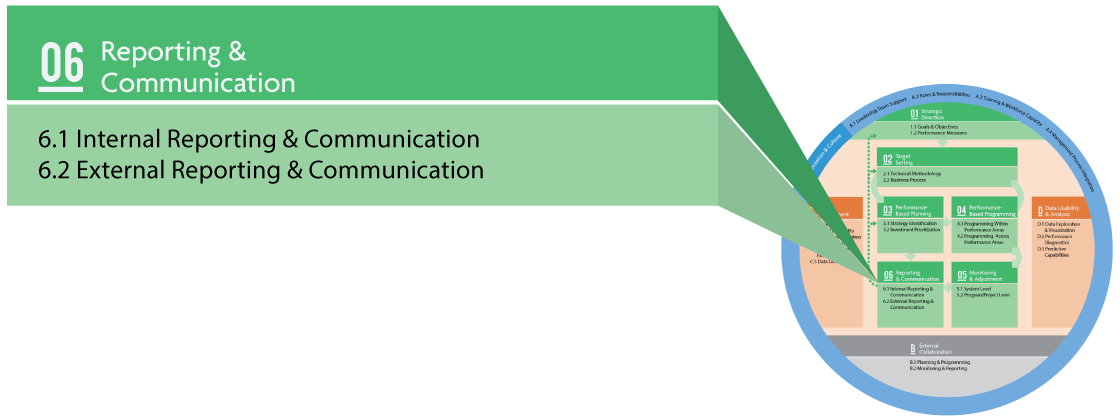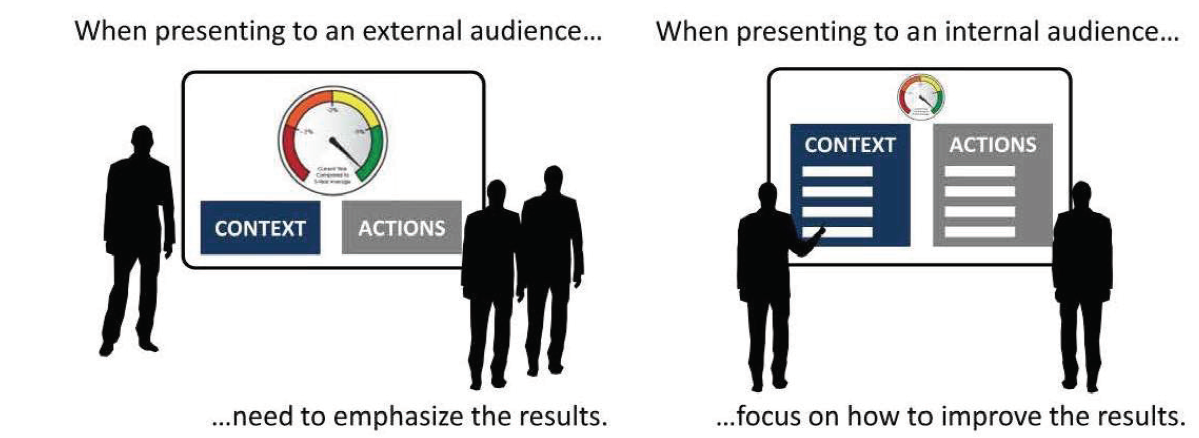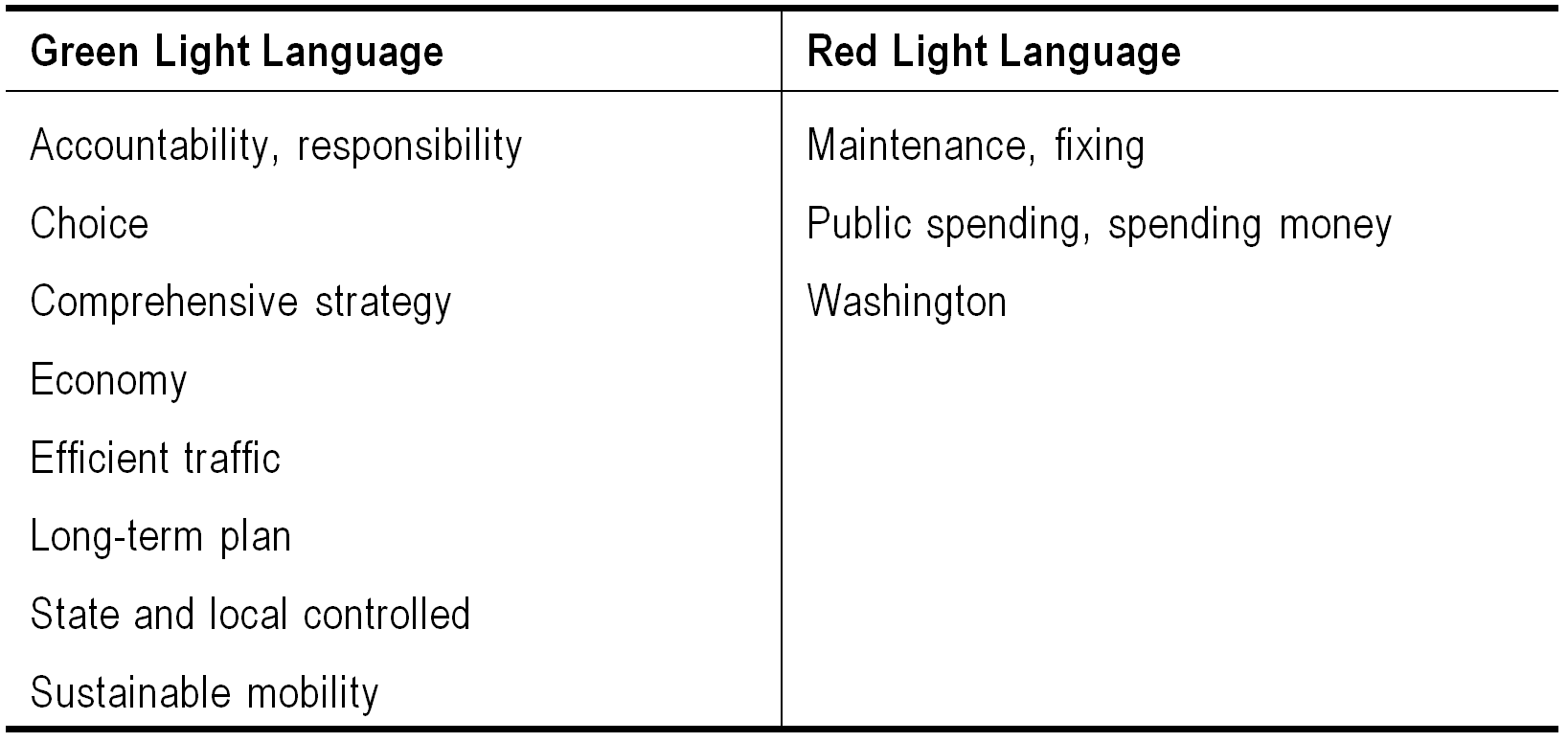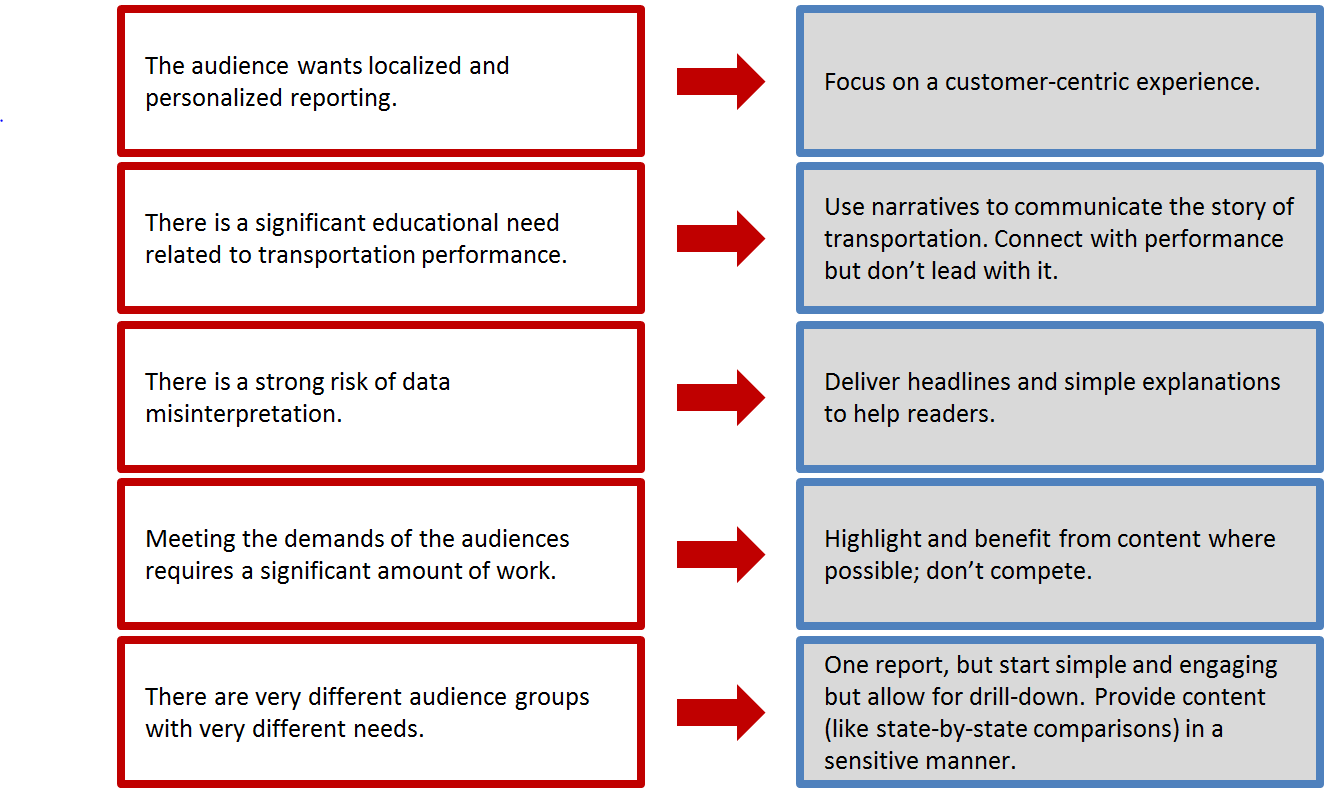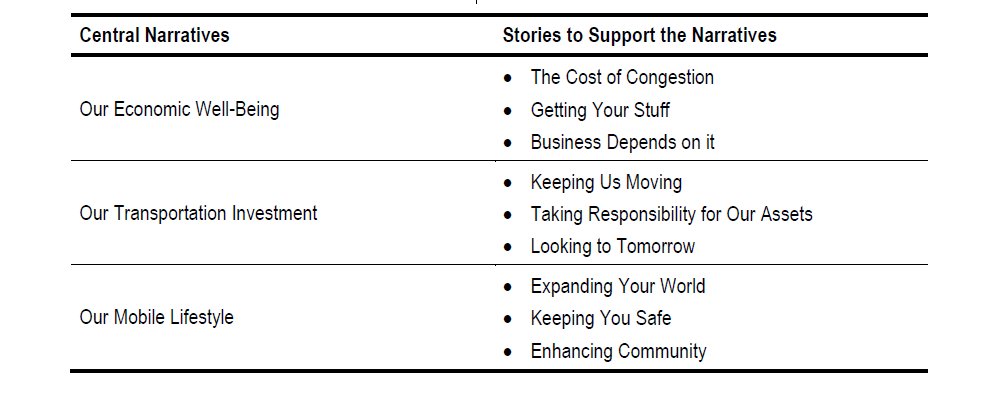Component 06
Reporting and Communication
This chapter provides assistance to transportation agencies with the Reporting and Communication component of Transportation Performance Management (TPM). It discusses where reporting occurs within the TPM Framework, describes how it interrelates with the other nine components, presents definitions for associated terminology, provides links to regulatory resources, and includes an action plan exercise. Key implementation steps are the focus of the chapter. Guidebook users should take the TPM Capability Maturity Self-Assessment as a starting point for enhancing TPM activities. It is important to note that federal regulations for reporting and communication may differ from what is included in this chapter.
Reporting and Communication is comprised of the products, techniques, and processes used to communicate performance information to different audiences for maximum impact. Reporting is an important element for increasing accountability and transparency to external stakeholders and for explaining internally how transportation performance management is driving a data-driven approach to decision making.
Introduction to Reporting and Communication
Reporting and Communication is a key component of transportation performance management. Whether the agency is advancing toward attaining its strategic goals, falling behind or somewhere in between – TPM demands a rigorous reporting and communications practice to promote transparency and accountability. In addition, the sharing of performance information fuels the feedback loop to the strategic direction (Component 01), the setting of targets (Component 02), the identification and evaluation of strategies (Component 03), and the programming decisions (Component 04). Information included in reporting is an output of monitoring and adjustment processes (Component 05).
The Reporting and Communication process benefits an agency by:
- Promoting an open atmosphere through the sharing of performance results
- Enabling reevaluation of measures, targets, and strategies
- Facilitating a refocusing on goals/objectives
- Providing the opportunity to build internal and external support
- Sharing of results/attainment and non-attainment of targets
Reporting and Communication products should be:
- Tailored to the audience: To be effective, reporting products must be specifically designed for a particular audience.
- Linked to funding: In an era of budget constraints and significant need, agencies must use reports and communication strategies to convey how funding levels impact results.
- Telling a story: Simply reporting numbers and data is not effective; reporting should provide necessary context to ensure the agency controls the message and the user understands it.
Performance-based planning builds on the foundation established by the Strategic Direction (Component 01) and Target Setting (Component 02). The planning process provides a forum to discuss, both internally and externally, how to turn strategic goals into actions on the ground. For each strategic goal, agencies examine performance trends to identify focus areas, derive strategies to address performance challenges and/or maintain existing results, and analyze alternative scenarios. Ensuing tradeoff discussions determine which strategies will be pursued and become concrete projects during the programming phase. The resulting planning documents become the blueprint for how an agency intends to achieve its goals and in turn its desired performance levels.
Performance-based planning is based on several main ingredients:
- Data and measures: Data and measures used to establish targets (Component 02) will be documented, reiterated within performance-based plans, and used to drive the development of strategies;
- Stakeholder input: Along with data, the plans are developed with visioning input from public engagement and the input of external partners;
- Policy considerations: Identified strategies must reflect the policies and procedures of local, state, and Federal partners; and
- Sharing data and information among silos: By its nature, the planning process facilitates communication and understanding among silos of expertise. The evaluation of strategies across performance areas requires open communication and exchange of information to better understand tradeoffs and the likelihood of success within a particular context.
Subcomponents and Implementation Steps
Well-crafted communications products, whether a website filled with data or a printed banner highlighting a recent performance success, are vital tools for informing and involving both internal and external audiences in TPM. Such products are also an opportunity to articulate the connection between agency strategies and outcomes achieved. Linking decisions to results builds support among internal staff and external partners, as well as demonstrates the impact of increased or decreased funding.1
“Measuring performance is of no value unless results are reported to the appropriate audiences in a way that makes the information readily understandable.”
Source: NCHRP Report 446: A Guidebook for Performance-Based Transportation Planning
Communications products should build context and continuity so that the audience easily understands key takeaways regardless of prior familiarity. To this end, it is helpful to repeat or review prior performance before reporting new information. In addition, it is important to explain how reporting fits within the overall transportation performance management process.2
Information must be shared in ways that are appropriate to the intended audience, which means that internal and external reporting and communication practices will differ,3 as demonstrated by Figure 6-1.
Figure 6-1: Tailoring Reporting by Audience
Source:US Department of Transportation4
AASHTO performed a research project focusing on strategies used to make a case for transportation projects, resulting in “The New Language of Mobility.”5 This research found that the public reacts more favorably to transportation efforts requiring increased revenue when certain words are used (green light language) to illustrate benefit, while other words should be avoided (red light language). Figure 6-2 below highlights examples of such language:
Figure 6-2: AASHTO Effective Communication Language
Source: AASHTO6
Because of the dual nature of reporting and communicating, this chapter has two subcomponents:
- Internal Reporting and Communication: products, techniques, and processes used to communicate performance information to internal audiences.
- External Reporting and Communication: products, techniques, and processes used to communicate performance information to customers, partner agencies, elected officials, and other stakeholders.
Internal communications target a wide variety of audiences, including the Board of Directors, department managers, and maintenance staff. While these reports will present information differently and with varying levels of detail, they will likely be used for at least some of the items in Table 6-1.7
Source: Federal Highway Administration
| Internal | External |
|---|---|
| Clarify how individual employees contribute to the performance results | Clarify outcomes achieved |
| Integrate TPM process into agency functions | Coordinate with the work of regional partners |
| Communicate the value of TPM to the agency and recognize achievements | Track attainment and non-attainment of goals |
| Connect current results to future actions | Communicate the interconnections between multiple goals |
| Track achievement of targets | Make the case for additional funding |
| Establish feedback loop to adjust performance measures, targets, and strategies | Build rapport with external groups, including receiving feedback on desired improvements |
External communication is an opportunity to explain the TPM process to external stakeholders and how performance information is used in agency decision making. Reporting and communication embody the tenets of TPM: accountability and transparency. Goals, measures, and targets established in TPM Component 01 and 02 should be prominent in external reporting. Agencies should describe the performance-based decisions made and expected results in terms that external stakeholders will readily understand and avoid using jargon and technical language.8 Based on audience and research feedback, FHWA’s Performance Reporting Final Report9 identifies five of the most significant problems when communicating results, and aligns them with solutions, as depicted below.
Figure 6-3: Performance Reporting Framework
Source: US Department of Transportation10
As stewards of the public’s investment in transportation, the agency is accountable for using funds prudently. As illustrated in Figure 6-3, effective reporting shows customers that the agency is meeting this expectation, but also presents an opportunity to manage expectations by explaining challenges, discussing targets and clarifying accomplishments. Context should be provided when targets are exceeded or missed and when results differ from peer agencies or national trends.11
Figure 6-4 highlights research that found “telling a story” is imperative when trying to persuade an audience. Developing a narrative not only educates, but can serve to engage an audience and illustrate how transportation impacts one’s life. FHWA’s Performance Reporting Final Report highlights three central narratives and how these might align to tell a story, as shown below.
Figure 6-4: Developing Effective Narratives
Source: US Department of Transportation12
Table 6-2 provides examples of how communications to different audiences will have different purposes in addition to differing levels of detail and focus. As a result, even though the same basic material is used and in many cases the same staff develops both external and internal reporting, the types of products can differ in terms of their approach and content.13
Source: Federal Highway Administration
| Audience | Potential Purpose |
|---|---|
| Internal Staff | Motivate productivity and efficiency |
| External Partners | Leverage greater investment and collaboration |
| Leadership (i.e., Governor) | Drive policy relating to a given goal |
| Regulatory | Meet legislative requirements |
Source: Federal Highway Administration
| Internal | External |
|---|---|
| 1. Clarify purpose of the report | 1. Clarify purpose of the report |
| 2. Define roles and responsibilities | 2. Define roles and responsibilities |
| 3. Develop reporting parameters | 3. Coordinate with external partners |
| 4. Refine, automate, and document | 4. Develop reporting parameters |
| 5. Refine, automate, and document |
Clarifying Terminology
Table 6-4 presents the definitions for the reporting and communication terms used in this Guidebook. A full list of common TPM terminology and definitions is included in Appendix C: Glossary.
Source: Federal Highway Administration14
| Common Terms | Definition | Example |
|---|---|---|
| Goal | A broad statement of a desired end conditions or outcome; a unique piece of the agency’s vision. | A safe transportation system. |
| Mission | Statement that reflects the core functional purpose of an agency. | Plan, build, operate and maintain a safe, accessible, efficient and reliable multimodal transportation system that connects people to destinations and markets throughout the state, regionally and around the world.15 |
| Objective | A specific, measurable statement that supports achievement of a goal. | Reduce the number of motor vehicle fatalities. |
| Outcome | Results or impacts of a particular activity that are of most interest to system users. Focus of subcomponent 5.1 System Level Monitoring and Adjustment. | Transit travel time reliability, fatality rate, percent of assets within useful life. |
| Output | Quantity of activity delivered through a project or program. Focus of subcomponent 5.2 Program/Project Level Monitoring and Adjustment. | Miles of pavement repaved, miles of new guardrail put into place, the number of bridges rehabilitated, the number of new buses purchased. |
| Performance Measure | Performances measures are based on a metric that is used to track progress toward goals, objectives, and achievement of established targets. They should be manageable, sustainable, and based on collaboration with partners. Measures provide an effective basis for evaluating strategies for performance improvement. | Transit passenger trips per revenue hour. |
| Target | Level of performance that is desired to be achieved within a specific time frame | Two % reduction in fatality rate in the next calendar year. |
| Transportation Performance Management | A strategic approach that uses system information to make investment and policy decisions to achieve performance goals. | Determining what results are to be pursued and using information from past performance levels and forecasted conditions to guide investments. |
| Vision Statement | An overarching statement of desired outcomes that is concisely written, but broad in scope; a vision statement is intended to be compelling and inspiring. | Minnesota’s multimodal transportation system maximizes the health of people, the environment, and our economy. |
Relationship to TPM Components
The ten TPM components are interconnected and often interdependent. Table 6-5 summarizes how each of the nine other components relate to the performance-based planning component.
Source: Federal Highway Administration
| Component | Summary Definition | Relationship to Performance-Based Planning |
|---|---|---|
| 01. Strategic Direction | The establishment of an agency’s focus through well-defined goals/objectives and a set of aligned performance measures. | The Strategic Direction provides the context surrounding performance reporting. |
| 02. Target Setting | The use of baseline data, information on possible strategies, resource constraints and forecasting tools to collaboratively establish targets. | Reports use targets as references; performance results inform the achievability of targets. |
| 03. Performance-Based Planning | Use of a strategic direction to drive development and documentation of agency strategies and priorities in the long-range transportation plan and other plans. | Reporting of performance levels informs adjustment of agency strategies and the prioritization of strategies to drive target attainment. |
| 04. Performance-Based Programming | Allocation of resources to projects to achieve strategic goals, objectives and performance targets. Clear linkages established between investments made and their expected performance outputs and outcomes. | Reporting compares expected to actual outputs and outcomes, enabling adjustment of programming to refocus on goals, objectives and performance targets. |
| 05. Monitoring and Adjustment | Processes to monitor and assess actions taken and outcomes achieved. Establishes a feedback loop to adjust programming, planning, and benchmarking/target setting decisions. Provides key insight into the efficacy of investments. | Monitoring provides the information to be reported, and communication of monitoring results drives adjustment of agency processes. |
| A. TPM Organization and Culture | Institutionalization of a TPM culture within the organization, as evidenced by leadership support, employee buy-in, and embedded organizational structures and processes that support TPM. | Reporting addresses each group within the agency, building knowledge of and focus on transportation performance management by all staff while connecting multiple TPM processes. |
| B. External Collaboration and Coordination | Established processes to collaborate and coordinate with agency partners and stakeholders on planning/ visioning, target setting, programming, data sharing, and reporting. | External reporting establishes trust and encourages transparency and dialogue with external partners and other stakeholders. |
| C. Data Management | Established processes to ensure data quality and accessibility, and to maximize efficiency of data acquisition and integration for TPM. | Developed data management processes streamline the reporting process by making information readily accessible and useful. |
| D. Data Usability and Analysis | Existence of useful and valuable data sets and analysis capabilities, provided in usable, convenient forms to support TPM. | Mature data usability and analysis capabilities enable tracking of agency outputs and outcomes to be reported. |
Regulatory Resources
This Guidebook is intended to assist agencies with implementing transportation performance management in a general sense, and not to provide guidance on compliance and fulfillment of Federal regulations. However, it is important to consider legislative requirements and regulations when using the Guidebook. In many cases, use of this Guidebook will bring an agency in alignment with Federal requirements; however, the following sources should be considered the authority on such requirements:
Federal Highway Administration
- Transportation Performance Management: http://www.fhwa.dot.gov/tpm/links_fhwa.cfm
- Fact Sheets on Fixing America’s Surface Transportation (FAST) Act: https://www.fhwa.dot.gov/fastact/factsheets/
- Fact Sheets on Moving Ahead for Progress in the 21st Century (MAP-21): https://www.fhwa.dot.gov/map21/factsheets/
- Resources on MAP-21 Rulemaking: https://www.fhwa.dot.gov/tpm/rule.cfm
Federal Transit Administration
- Fact Sheets on FAST Act: https://www.transit.dot.gov/funding/grants/fta-program-fact-sheets-under-fast-act
- Resources on MAP-21: https://www.transit.dot.gov/regulations-and-guidance/legislation/map-21/map-21-program-fact-sheets
